
Pycnodus is an extinct genus of ray-finned fish from the Eocene period. It is wastebasket taxon, although many fossils from Jurassic or Cretaceous are assigned to this genus, only Eocene species, P. apodus is valid. As its name suggests, it is the type genus of Pycnodontiformes.
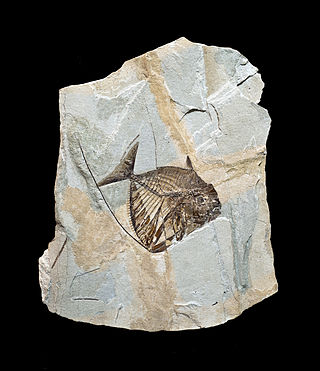
Mene rhombea is an extinct perciform fish belonging to the family Menidae. During the Middle Eocene, about 48 to 40 mya, these fishes lived in the Tethys Ocean, a large tropical sea in the area corresponding to the current Mediterranean. This ocean was extended between the continents of Gondwana and Laurasia. At this time, where Monte Bolca is today, M. rhombea, and its relative, M. oblonga, lived in a tropical lagoon.

The moonfish of the genus Mene, the sole extant genus of the family Menidae, are disk-shaped fish which bear a vague resemblance to gourami, thanks to their thread-like pelvic fins. Today, the genus is represented only by Mene maculata of the Indo-Pacific, where it is a popular food fish, especially in the Philippines, where it is known as bilong-bilong, chabita, hiwas or tahas.
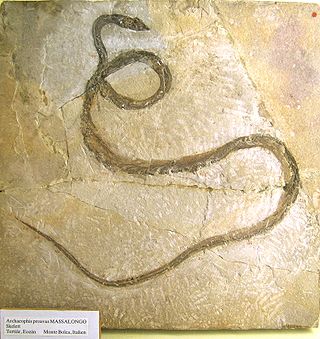
Bolca is a village in the Veneto, on the southern margin of the Italian Alps. It is a frazione of the comune of Vestenanova, in the province of Verona. The area is famous for the marine fossils from the lagerstätte of Monte Bolca. It was one of the first fossil sites with high quality preservation known to Europeans, and is still an important source of fossils from the Eocene.
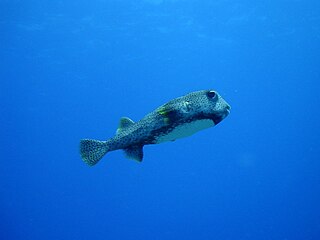
Porcupinefishes or balloonfishes, are any of the various species of the genus Diodon, the type genus of Diodontidae.

Urolophus is a genus of round rays mostly native to the western Pacific Ocean and the Indian Ocean, though one species occurs in the Pacific waters of the Mexican coast. Müller and Henle erected Urolophus in an 1837 issue of Bericht Akademie der Wissenschaften zu Berlin. The name is derived from the Greek oura, meaning "tail", and lophos, meaning "crest". In Urolophus, the outer rims of the nostrils are not enlarged into lobes, but may form a small knob at the back.

Zignoichthys oblongus is an extinct prehistoric relative of the pufferfish and porcupine fish that lived during the Lutetian epoch of the Eocene. Z. oblongus' fossils are found from the Monte Bolca lagerstätte of what is now Italy.
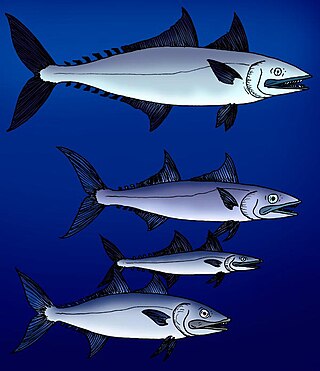
Euzaphlegidae is a family of extinct escolar-like fish closely related to the snake mackerels. Fossils of euzaphlegids are found from Paleocene to Late Miocene-aged marine strata of Europe, the Caucasus Mountains, India, Iran, Turkmenistan, Italy, and Southern California.
Palaeopomacentrus orphae is an extinct species of fish from the Ypresian epoch of Monte Bolca. It is the only known species of the genus Palaeopomacentrus.

Incisoscutum is an extinct genus of arthrodire placoderm from the Early Frasnian Gogo Reef, from Late Devonian Australia. The genus contains two species I. ritchiei, named after Alex Ritchie, a palaeoichthyologist and senior fellow of the Australian Museum, and I. sarahae, named after Sarah Long, daughter of its discoverer and describer, John A. Long.
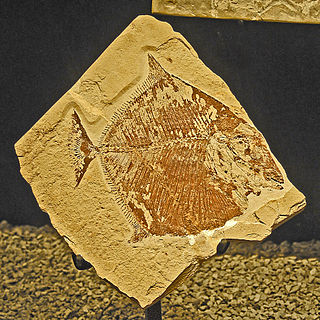
Palaeobalistum is an extinct genus of prehistoric ray-finned fish which ranged from the Cretaceous to Eocene periods.
Pietschellus is an extinct genus of enigmatic bony fish which existed in northern Italy during the early Eocene epoch. It is known from a single well-preserved nearly complete specimen recovered from the Monte Postale site of the Monte Bolca locality. It was first named by Alexandre F. Bannikov and Giorgio Carnevale in 2011 and the type species is Pietschellus aenigmaticus.

Asterotrygon is an extinct genus of stingray from the Eocene Green River Formation in Wyoming. Several complete skeletons representing juveniles, adults, males and females have been uncovered from the late early Eocene Fossil Butte Member of the formation. The type and only species, A. maloneyi, was named in 2004 on the basis of these fossils. Another stingray, Heliobatis, is also known from the formation. Asterotrygon is a primitive stingray closely related to the living family Urolophidae whose ancestors likely originated in the Indo-Pacific. It lived in Fossil Lake, a body of water that existed in a subtropical mountainous region for only about 2 million years.
Sharfia mirabilis is an extinct species of anglerfish in the family Lophiidae. It was discovered in 2011 during a review of fossil material at the Muséum national d'histoire naturelle in Paris. The fossil material was collected from the Monte Bolca Lagerstätte, one of the earliest known Eocene fossil sites. The undescribed genus was originally identified as Lophius brachysomus.

Pristigenys is a genus of marine ray-finned fish in the family Priacanthidae. It contains five extant species and one extinct species, P. substriata, which is known from fossils found in the Eocene of Monte Bolca, Italy.
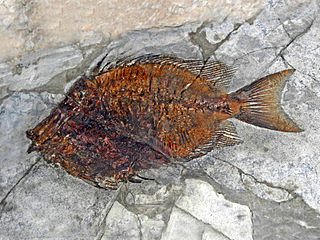
Naseus is an extinct genus of surgeonfishes from the Lutetian-aged Monte Bolca Lagerstätte.

Lophius brachysomus is an extinct species of anglerfish in the family Lophiidae. It was described by Louis Agassiz in 1835 from the Monte Bolca locality. It became extinct during the middle Eocene.

Eogaleus is an extinct genus of requiem shark from the Eocene epoch. It contains a single species, E. bolcensis. It is known from multiple articulated individuals from the Bolca Konservat−Lagerstätte of the Ypresian of Italy. It was a shallow water species.
Arechia is an extinct genus of stingaree from the Eocene epoch. It is the oldest known stingaree genus, though molecular data suggests they diverged from Butterfly rays about 75 million years ago or from Deepwater stingrays around the time of the K-Pg transition. The type species, A. arambourgi, is known from isolated teeth found in the Ypresian deposits of Ouled Abdoun, Morocco. It is named for Camille Arambourg, who originally ascribed these teeth to Raja praealba in 1952. Henri Cappetta revised the species in 1983, erecting this genus for those Arambourg called males in this genus and placed the ones he called females in Merabatis. The second species, A. crassicaudata is from the Ypresian-age Bolca Lagerstätte of Italy and is known from several articulated individuals. This species was described in 1818 and was placed in various genera until finally being attributed to this one in 2020. The inferred environment of the Monte Postale site where this species is found matches with the typical warm, shallow environment of extant representatives of this family.















